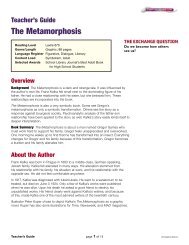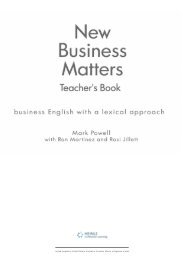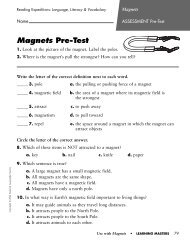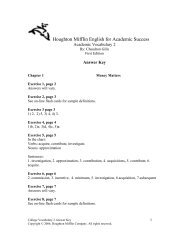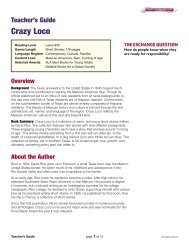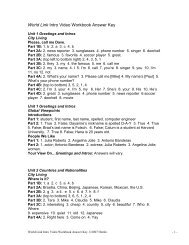English for Cabin Crew Trainer's Guide - Heinle
English for Cabin Crew Trainer's Guide - Heinle
English for Cabin Crew Trainer's Guide - Heinle
You also want an ePaper? Increase the reach of your titles
YUMPU automatically turns print PDFs into web optimized ePapers that Google loves.
UNIT<br />
1 Case study<br />
LEAD IN Speaking<br />
Write Getting ready <strong>for</strong> work on the board. Ask students to think<br />
of three things they always do be<strong>for</strong>e going to work. Then tell<br />
them to discuss their ideas with a partner. Have an open class<br />
discussion and fi nd out if anyone has an unusual routine.<br />
Lead in to the reading by asking students to make their own<br />
list of things a fl ight attendant has to check be<strong>for</strong>e passengers<br />
board. Then, when students read, ask them <strong>for</strong> similarities and<br />
differences between the list in the text and their lists.<br />
EXERCISE 1 Reading<br />
Ask students to read the text and fi nd answers to the questions. Let<br />
students discuss the answers in pairs be<strong>for</strong>e discussing in open class.<br />
Answers<br />
1 the emergency equipment, the safety instruction card, the number of<br />
meals on board, the usual drinks trolley and duty-free goods, and that<br />
the toilets are all stocked with the necessary hand towels and tissues<br />
2 security and the aircraft’s safety features<br />
Vocabulary in context<br />
You could get students to fi nd and revise words in the text that are<br />
connected with their job. Ask students in pairs to fi nd words <strong>for</strong> each of<br />
the categories below:<br />
People on a plane: crew, purser, passengers, staff, captain<br />
Things on a plane: carry-on bag, uni<strong>for</strong>m, emergency equipment, exits,<br />
seat pocket, safety instruction card, drinks trolley, duty free goods, toilets<br />
EXERCISE 2 Speaking<br />
The aim here is to get students talking about their personal experiences.<br />
Give students time to read through the situation and questions and<br />
think of responses. Ask them to discuss their responses in pairs or small<br />
groups. After a few minutes, get one student from each pair or group to<br />
briefl y summarize the main points of their discussion.<br />
EXERCISE 3 Speaking<br />
Give students time to read through the things and check any diffi cult<br />
words. Then ask students to discuss them in pairs be<strong>for</strong>e ending with a<br />
brief open class discussion.<br />
Pre-teaching vocabulary<br />
You could pre-teach some of the key adjectives used in the interview.<br />
Write the following on the board and check the meaning and<br />
pronunciation: terrifying; intense (not relaxed); nerve-wracking (very<br />
worried); exciting; relaxing, stern (strict, severe); tense (not relaxed);<br />
in<strong>for</strong>mative; enjoyable; interesting; serious; poignant (sad). Ask students<br />
which of these words best describe a briefi ng meeting.<br />
EXERCISE 4 and 5 Listening<br />
Give students time to read the situation and questions in exercise 4. Play<br />
the recording. Students listen and then discuss their answers in pairs.<br />
Get feedback in open class at the end.<br />
Follow the same procedure <strong>for</strong> exercise 5.<br />
Answers<br />
1 She was partly terrifi ed and very excited.<br />
2 The actual content was always the same; the atmosphere could be<br />
different – sometimes friendly, sometimes tense.<br />
3 VIPs / celebrities, passengers who are travelling <strong>for</strong> sad reasons, such<br />
as to visit someone who is sick or has had an accident.<br />
CD1 Track 1.7<br />
1 What do you remember about your fi rst pre-fl ight briefi ng?<br />
S: My fi rst fl ight was a mixture of emotions. I was partly terrifi ed and very<br />
excited. I was terrifi ed because the training we'd been given over the six<br />
weeks was quite intense and I knew that arriving at the briefi ng room I<br />
would be asked a series of questions and I had to get those answers right<br />
to show that my training profi ciency was up to standard so that was very<br />
nerve-wracking, but I was also really, really excited – I was, you know, part<br />
of this team that was going to be taking a fl ight with, you know, a 100 or so<br />
passengers from one country to another and that was just unbelievable.<br />
2 Were these briefi ngs always the same?<br />
S: The actual content of the briefi ng was always the same. However, depending<br />
on the human factor with different people you're working with, some people,<br />
those in charge, would help create a friendlier environment so you could relax<br />
a little more and others would put the fear of God into you because, you know,<br />
their sternness, their facial expressions, etcetera, so it was always very tense<br />
going into those pre-briefi ngs and you never quite knew what the atmosphere<br />
would be, but on the whole it was, it was the same in content.<br />
3 What was the common theme?<br />
S: Having worked <strong>for</strong> a number of different airlines, both charter work and<br />
scheduled international and short-haul, there was a common theme with the<br />
pre-briefi ngs throughout the industry and that was primarily safety and, of<br />
course, passenger in<strong>for</strong>mation. Those briefi ngs were used as an opportunity to<br />
in<strong>for</strong>m and advise the crew of what type of passengers they were having on<br />
board; the service that day, but predominantly it was safety related. One of<br />
the things I really enjoyed about the pre-fl ight briefi ngs was the opportunity<br />
to meet the crew that you would be working with that day or that week and<br />
getting to know about the fl ight and, you know, the particular idiosyncrasies<br />
that would occur. For example, on some fl ights we may have VIPs and that<br />
was always exciting to know that you're carrying someone, you know, of a<br />
celebrity status or it may be that you're carrying, you know, a passenger who<br />
has, you know, got to travel through sad reasons. Perhaps her daughter living<br />
out in New Zealand has just had a serious accident and she’s travelling to New<br />
Zealand to, to visit her sick daughter. All of those opportunities to fi nd out<br />
about the fl ight – some were more poignant than others, but it was always<br />
very interesting and exciting. A really, really nice opportunity to get to know<br />
about the day ahead.<br />
EXERCISE 6 Speaking<br />
Divide the class into pairs or small groups to discuss the questions.<br />
Get open class feedback, and encourage students with interesting<br />
experiences to share with the class.<br />
ROUND UP<br />
Revise vocabulary from the unit by asking students to write<br />
words and phrases connected with the industry under the<br />
following headings:<br />
People / Duties / Parts of the plane / Weather<br />
Ask students to work in pairs to write all the words and phrases<br />
they know, or to search the unit to fi nd words and phrases to<br />
write.<br />
7



